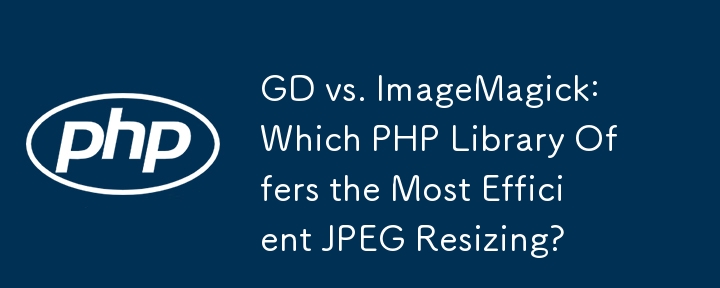

Efficient JPEG Image Resizing in PHP: Evaluating GD and ImageMagick
Resizing large JPEG images in PHP presents a computational challenge, particularly with files exceeding 2 MB or dimensions of 5000x4000 pixels. This article will compare two popular PHP image manipulation libraries: GD and ImageMagick, to determine which provides the most efficient solution for this task.
GD Resizing Implementation
The provided GD resizing code follows a common approach, loading the source image, calculating dimensions, creating a temporary image, and performing resampling before saving the resulting thumbnail. However, this approach can consume excessive memory when dealing with large images.
ImageMagick as an Alternative
ImageMagick is widely recognized for its superior performance in image processing tasks. It offers a wider range of features and a more optimized API than GD. Additionally, ImageMagick can leverage system resources more efficiently, potentially resulting in faster execution times.
Direct Comparison
To objectively assess the performance difference between GD and ImageMagick, the following steps are recommended:
By comparing these metrics, you can determine which library offers the most efficient solution for your specific use case. It's important to consider factors such as memory consumption, execution speed, and image quality to make an informed decision.
Conclusion
While ImageMagick is often considered more efficient than GD for image resizing, it's essential to conduct your own benchmark to verify this assumption in context. By evaluating performance metrics and considering your application's specific requirements, you can select the optimal image manipulation library for your PHP application.
The above is the detailed content of GD vs. ImageMagick: Which PHP Library Offers the Most Efficient JPEG Resizing?. For more information, please follow other related articles on the PHP Chinese website!
 How to light up Douyin close friends moment
How to light up Douyin close friends moment
 What should I do if my computer starts up and the screen shows a black screen with no signal?
What should I do if my computer starts up and the screen shows a black screen with no signal?
 Kaspersky Firewall
Kaspersky Firewall
 plugin.exe application error
plugin.exe application error
 nvidia geforce 940mx
nvidia geforce 940mx
 Do you know if you cancel the other person immediately after following them on Douyin?
Do you know if you cancel the other person immediately after following them on Douyin?
 How to calculate the refund handling fee for Railway 12306
How to calculate the refund handling fee for Railway 12306
 Top ten digital currency exchanges
Top ten digital currency exchanges




